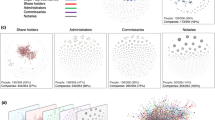Abstract.
Corruption all over the world is an ancient, but it seems very topical too, concern in politics and in the media. This paper investigates spatial and dynamic aspects of corruption using cellular automata. Although cellular automata are very simple, deterministic machines and thus crude approximations of real, economic situations, they are capable of describing self organization and complex patterns (of corruption). It is shown that neither social pressure nor pure economic incentives allow for complex patterns, although social pressure may lead to clusters of corrupt and uncorrupt segments within a bureaucracy. However, blending both above characteristics is capable explaining complex behavior. Extending the concept of cellular automata through mixing rules – across space (= bureaucrats) and time (accounting for global effects) – does not affect the fundamental properties.
Similar content being viewed by others
Author information
Authors and Affiliations
Rights and permissions
About this article
Cite this article
Wirl, F. Socio-economic typologies of bureaucratic corruption and implications. J Evol Econ 8, 199–220 (1998). https://doi.org/10.1007/s001910050062
Issue Date:
DOI: https://doi.org/10.1007/s001910050062




